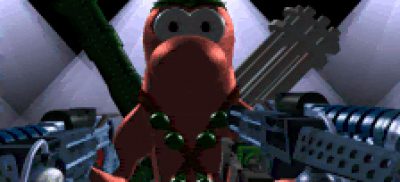Welcome to the Team17 100 games retrospective, celebrating our 100th release, PLANET ALPHA. In this chapter we’re looking back at 1995, an historic year in Team17 history, when Alien Breed made the leap into three dimensions and when the studio changed forever, following the discovery of Worms!
Don’t forget to check out our previous chapters on 1991/92, 1993 & 1994 for more retro goodness!
23/100
ATR: All Terrain Racing
Year: 1995 | Developer: Team17 | Publisher: Team17 | Format: Amiga, CD32
Putting the “team” in Team17, ATR: All Terrain Racing saw Qwak’s Jamie Woodhouse join forces with Body Blows creator Danny Burke to make a particularly beautiful arcade racer.
“ATR actually started out as a top-down 2D racer,” says Woodhouse. “I was aiming for something along the lines of what Retro Racing* turned out to be. Danny Burke had coincidentally been working on graphics for an isometric racer and we decided to work together. For my part, inspiration was very much Super Sprint and Sega’s excellent Hot Rod, and of course all the experience I’d had with the development of Nitro.”
Burke tells the story from his perspective… “Martyn Brown saw design mock-ups I’d made for the game and knew that Jamie was working on something similar and put us on the project. Jamie wanted pre-rendered cars and I didn’t,” he adds. We guess he got his way! “Being isometric made things a little more difficult, but I liked the idea of driving behind objects. All my games tend to be very colourful. I was inspired by arcade games from SNK, Capcom and Sega.”
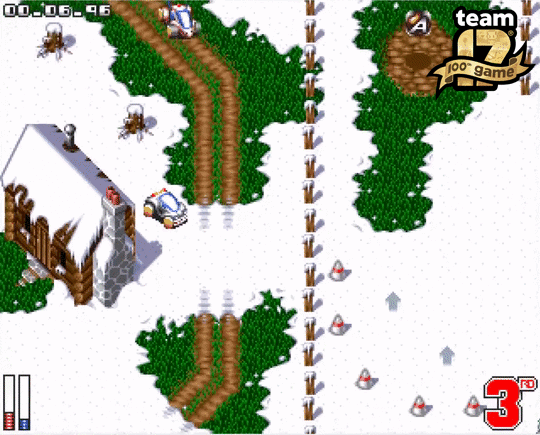
ATR’s wintery stages were also tweaked and released as a special Christmas Edition Amiga Format cover disk in late ’94.
“The part of ATR I’m most proud of is the handling,” adds Woodhouse. “How they perform differently over various terrain types. They’re little touches you may not consciously notice, but I think as a player you feel and appreciate they’re there; like when your car hits a rock or bump in the road and momentarily bounces in the air leaving you unable to steer; or as you drive over rough ground your car wobbles so you have to keep recalibrating and adjusting your direction of travel to compensate.”
Aside from a disappointing 38% review score in Amiga Power, ATR was generally very well received, with other mags rating the game around the 70-90% zone and raving about both the graphics and handling. Proving, we’d argue, that Woodhouse and Burke made a better game together than they would have apart. Go team!
24/100
Kingpin: Arcade Sports Bowling
Year: 1995 | Developer: Team17 | Publisher: Team17 | Format: Amiga, CD32, PC
After the success of Arcade Pool in 1994, a mini-franchise of sorts was launched, the Arcade Sports series! In truth it didn’t last all that long. Arcade Pool would eventually get a sequel, while a promising “Sensible Soccer” style Amiga cricket game called Final Over: Arcade Sports Cricket was cancelled around 1995.
But that’s a story for another time! Kingpin took the philosophy of Arcade Pool – budget price, accessible gameplay and authentic atmosphere – and applied it to ten pin bowling. A simple swing/power control interface, tried and tested by countless other bowling games, made Kingpin easy to pick up so that just about anyone could play and have fun. Which was more important than you might think when you consider that Amigas were, at least occasionally, installed as family computers and would have been used by people of all kinds of gaming tastes and skill levels.
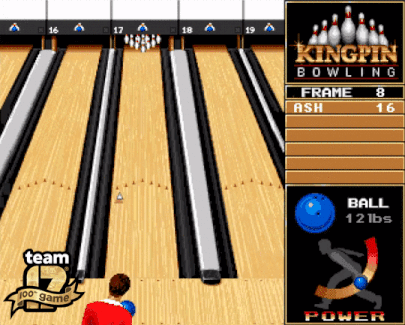
For extra authenticity the in-game digital scoreboard was modelled exactly like the video scoreboards you would have seen in bowling alleys of the time – and probably to this day – while the sound effects were recorded directly from the real thing. Special thanks in the manual even went tos to Wakefield’s “Superbowl 2000”, just down the road from the Team17 office for help, info and a doggy lane 7! Alien Breed voice artist extraordinaire Lynette Reade also popped in to play the bowling alley PA operator to make dry announcements about the car park! Just like the real thing.
25/100
Alien Breed 3D
Year: 1995 | Developer: Team17 | Publisher: Ocean | Format: Amiga, CD32
Though the Amiga had ruled the roost of home computer gaming for many years, it was clear by the mid-Nineties that its days were sadly numbered. Platform holder Commodore had gone out of business in 1994, leaving the future of the hardware uncertain at best, while the IBM PC had begun to make huge strides in the wake of Windows 3.1 in 1992. The tide was turning, and Doom (a game that needs no introduction) was instrumental in that shift of the gaming landscape.
Everyone wanted their own “Doom clone”, and with id Software expressing no interest in porting the real thing to Amiga, the doors were wide open for Team17 to blast through with their own. But how could you create something so advanced on the ageing Amiga hardware? York based Andy Clitheroe had the answer… Prepare for jargon!
“It was actually a friend who got the ball rolling,” admits Clitheroe. “He had reverse engineered some demo and worked out the trick for faking a number-per-pixel mode on the Amiga 1200. The Amiga hardware used bit-planes to describe the screen, which made it great for parallax scrolling and other tricks, and memory efficient if you used fewer colours, but abysmal if you just wanted to set the colour of an individual pixel, which is what a game like Doom is all about. All the other Amiga Doom clones cottoned onto the same trick, of course, but that was just the start.”
“The base A1200 wasn’t up to the number crunching needed by Doom’s super-clever BSP-tree renderer, which is why most of the other Amiga clones stuck to grid-based levels that simplified the problem. I went down a different route, drawing the environment more like graphics cards do today as textured shapes, which made the maths more manageable but also meant I had to invent simplified versions of today’s occlusion-culling to avoid drawing too much and slowing the game down.”
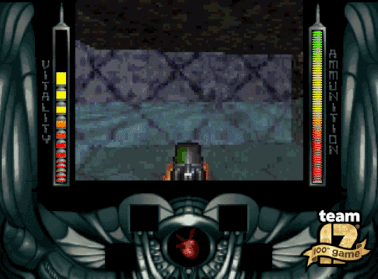
Clitheroe put together a demo and headed off to the pub with Team17’s Martyn Brown. “I asked for about ten grand, and I think he had trouble keeping a straight face,” he recalls. The demo proved so impressive that it was paired up with the Alien Breed franchise, its corridor shooting a perfect fit for the FPS genre. “I remember when I got the phone call saying I had the job, I went jumping around the house, tried to jump through a doorway, timed it wrong and cracked my head open on the lintel!”
If all the technical info above makes your head hurt as much as Andy’s did on that fateful day, then all you need to know is this… Alien Breed 3D was the real deal! It was Doom… On the Amiga! And it wasn’t just a tech demo, it was great fun to play! To understand the impact it had on Amiga gamers, take a look at the review scores. Every single Amiga mag in the UK rated AB3D over 90%! Although it ran in a little window in the middle of your TV screen, the game had it where it counts! The action was fast and frantic. The weapons dispatched enemies in a satisfying meat explosion and the game even found time to show off, with technical wonders like stairs! ramps! and underwater bits! In 1995, on the Amiga, this was astonishing.
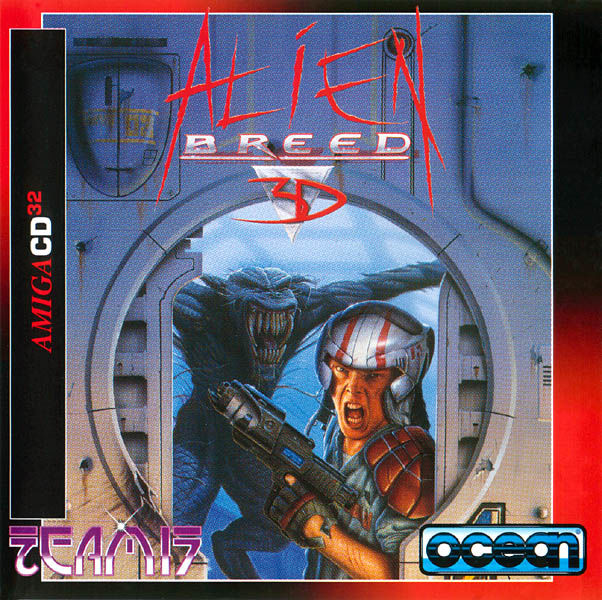
Alien Breed 3D was also released on CD, complete with an enhanced soundtrack and more levels!
Given all of the technical hurdles involved, Clitheroe is understandably proud of one thing over all others… “Finishing it!”
“There were a lot of challenges along the way and no internet to search for answers,” he explains, “so everything was self-taught. That means it probably wasn’t as good as it could have been, but I’m happy anyway. Rendering, sprite compression, path-finding, 8-channel sound, collision – a lot went into it.”
Despite actually having very little to do with the previous Alien Breed games – “I was so swamped just getting the basics of a first-person shooter implemented”, says Clitheroe – Alien Breed 3D was held up as the ultimate culmination of the series. In the context of Alien Breed’s lineage, it showed just how far the developers and the humble Amiga had come in just four years and felt like a fitting climax. Though it was far from the final entry…
26/100
Worms
Year: 1995 | Developer: Team17 | Publisher: Ocean | Format: Amiga, CD32, Game Boy, Jaguar, Mac, Mega Drive, PC, PlayStation, Saturn, SNES
Buy: GOG.com & Steam

Andy Davidson (left)
After five years of creating games almost exclusively for the Commodore Amiga, Team17 was catapulted into the world of multiformat development when a young lad called Andy Davidson, with an incredible imagination and talent for programming came to Team17 with Total Wormage, the game that would eventually be Worms.
“I set out to create a game that my mates and I could enjoy without it growing boring,” says Davidson, who built upon the classic artillery genre that had been popular on the shareware scene with games like Gorillas and Scorched Tanks by adding in his own style and humour, including those squeaky voiced worms and an arsenal of explosive weapons. “I loved seeing people’s reactions to the exploding sheep!”
Originally submitted to a coding contest in Amiga Format, the magazine was flooded with so many entries that Total Wormage went virtually ignored, leaving Davidson to pitch the game to Team17. “Going with Team17 was important to me because of their support of the Amiga, and it meant I was able to work with some very talented people.”A group of Team17 staff members were assigned to help Davidson finish the Amiga game, including founding member Rico Holmes on art duties. “The new background graphics were much better than I could have come up with myself,” says Davidson.
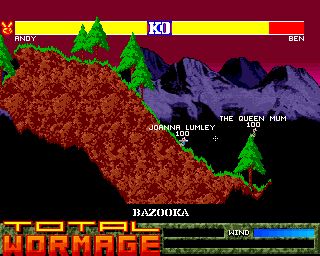
A rare screenshot of “Total Wormage” from around 1993/94
While the Amiga team helped complete Davidson’s vision, two other teams concentrated on the epic task of bringing the game to eight other formats – an undertaking never previously attempted by Team17. East Point Software, who had previously ported some of the Alien Breed games to PC, were brought in to create the Mega Drive, SNES and Game Boy versions – which you can read about in this Nintendo Life interview – while an internal team was set up to create the other versions, including the all-important PC and PlayStation releases. Unusually, these weren’t ports of the Amiga game, but were unique versions developed in parallel…
“We didn’t emulate or port the game code, we just looked at the game and wrote it from scratch,” recalls programmer Gary Symons. “Pieter Opdam did the gameplay so it was probably the hardest for him to get the feel Andy Davidson wanted. Since the Amiga version wasn’t finished we just ploughed ahead for the deadline, taking some design decisions ourselves. In the end, we finished some time before Andy. This did cause some conflict, but we couldn’t mess around, we had to make that deadline! I guess it’s like when authors see their book turned into a film and some of them aren’t happy with the filmmaker’s interpretation. Anyway, Andy and I bumped into each other a few years later after the successful release, and it was water under the bridge by then.”
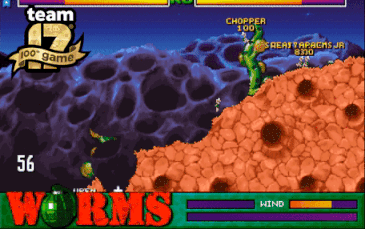
Symons remembers the moment, just after the release of the PC version, he realised Worms was going to be a massive hit… “We were working late at night and went into Ossett [the Yorkshire village where Team17 was then located] for dinner. In the kebab shop we waited for our meal and some kids came in singing the Wormsong. We looked at each other and smirked, we knew for sure then it was gonna be damn popular!”
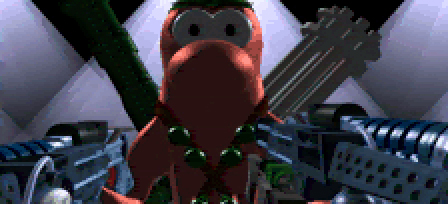
The CD version of Worms came with high tech CGI intro, animated by Cris Blyth on an Amiga with a 40Mhz(!) processor
“I’d always wanted to create a game that appealed to as many people as possible, even people who didn’t normally play computer games, so being ported to the other platforms and gaining that wider audience was nice to see,” adds Davidson. “Especially the console audience, as it also showed 2D games still had a place at a time when everything was going 3D. I’ve heard lots of stories over the years of people playing the PlayStation version with their mates at Uni, having a laugh till the early hours. Exactly the way the game was intended, and that makes me very happy.”
That’s your lot for 1995! In the next chapter we’ll delve into the post-Worms world of 1996, featuring the game’s first expansion, Alien Breed 3D’s ridiculously ambitious sequel, the long-awaited follow-up to Project X and our very own Zelda-alike, The Speris Legacy!
In the meantime, don’t forget to check out the previous chapters on 91/92, 93 & 94 and share your own Team17 memories with us on Twitter, using #100Team17!
*Retro Racing developed and published by Jamie Woodhouse



